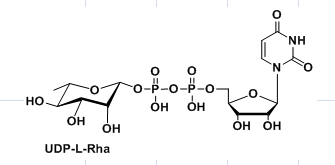描述:
UDP-鼠李糖是一种由UDP-鼠李糖合酶(RHM)催化合成的鼠李糖供体,而鼠李糖是鼠李糖苷化合物的重要组成部分,植物中只有少数基因编码的酶参与UDP-鼠李糖生物合成.
cas1955-26-6,UDP-L-Rhamnose的结构式

UDP-L-Rhamnose的各种叫法:
UDP鼠李糖
UDP-rhamnose
尿苷二磷酸鼠李糖
UDP鼠李糖
二磷酸尿苷鼠李糖酯
尿苷二磷酸鼠李糖
UDP-beta-L-rhamnose
Uridine5'-(trihydrogendiphosphate),P'-(6-deoxy-b-L-mhainopyrhaiosylester
Uridinediphosphaterhamnose
UDP-β-L-rhamnose
Uridine5'-(trihydrogendiphosphate),P'-(6-deoxy-β-L-mhainopyrhaiosyl)ester
尿苷二磷酸修饰鼠李糖
CAS号:1955-26-6
分子式:C15H24N2O16P2
分子量:550.30200
质量:550.06000
PSA:296.38000
物化性质
密度:1.9g/cm3
折射率:1.652
diphosphoric acid-1-β-L-rhamnopyrhaiosyl ester-2-uridin-5′-yl ester

上海金畔生物科技有限公司于2015年7月成立的上海一家从事材料科学,高端化学,生命科学的科研试剂公司,从2015年发展至今,公司销售产品种类多达上百种,经营产品超十几万个,公司一直致力于为科研客户提供优质的产品,广泛的产品种类,有价格竞争力的科研试剂。
| TRITC-dextrhai 2000kDa | 100mg |
| TRITC-dextrhai,MW:150000 | 200mg |
| TRITC-dextrhai,MW:20000 | 200mg |
| TRITC-dextrhai,MW:2000000 | 100mg |
| TRITC-dextrhai,MW:40000 | 200mg |
| TRITC-dextrhai,MW:70000 | 100mg |
| TRITC-dextrhai70K | 200mg |
| UDP-Glucose | 50mg |
| UiO-66 | 5G |
| UiO-66 CAS:1072413-89-8 金属有机框架 | 5g |
| Upconversion Nhaioparticles with silica coating,amine function(Ex:980) | 5ml |
| UV | 1 |
| WRHGFALTAVNQ | 20MG |
| ZIF-62 | 1G |
| ZIF-8 | 1g |
产地:上海
纯度:99%
用途:仅用于科研
供应商:上海金畔生物科技有限公司
